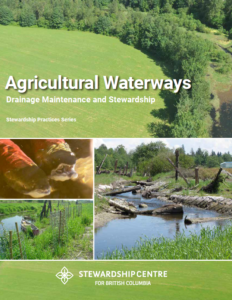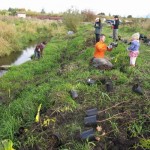 Learn how you can save money through environmental stewardship! Agricultural Waterways: Drainage Maintenance and Stewardship details the cost savings and environmental benefits of stewardship practices for agricultural waterways.
Learn how you can save money through environmental stewardship! Agricultural Waterways: Drainage Maintenance and Stewardship details the cost savings and environmental benefits of stewardship practices for agricultural waterways.
Did you know that proper drainage maintenance can include
- creating a low-flow, inset channel,
- appropriately storing and applying manure,
- restoring riparian areas, and
- planting cover crops.
But that’s not all – our latest update to this popular guide includes a suite of ways to mitigate impacts to fish and wildlife. We’ve also included potential funding sources, steps for a successful project, helpful web resources, and information about legal requirements.
This guide is one of our Stewardship Series intended to encourage people to take voluntary stewardship actions, called stewardship practices, to safeguard wildlife and species at risk. Our guide can help you achieve or maintain successful stewardship of riparian areas.
Agricultural waterways – streams, ditches, rivers, lakes, and wetlands that run through or beside agricultural lands – have inherent value and provide ecosystem services. They provide benefits to numerous wildlife species, including many species at risk. They connect habitat, regulate water temperature, and help minimize erosion. Benefits to nature and people are called ‘ecosystem services’ because our health, well-being, and economy depend on them. In addition to landscape-scale benefits, agricultural waterways offer numerous benefits to farmers and ranchers.
Agricultural waterways
- improve flood control,
- enhance drainage,
- provide cleaner water for irrigation,
- improve herd management (with riparian fencing),
- improve herd health (better weight gains, less foot rot), and
- increase income opportunities (Farmland Advantage, agroforestry).

Check out the full list in Agricultural Waterways here.
Have a question? Let us know how we can help! You can reach us by email, Facebook, or Twitter.
Case Studies
Our thanks to the farmers, ranchers, and land managers profiled in this guide. Our case studies include stewardship practices for agricultural waterways at
- Beaver Meadows Farm,
- Amaral Farm,
- Yarrow EcoVillage,
- Cedar Isle Farm,
- Holberg Farm, and
- Silver Hills Farm.
You can read about individual case studies here.
Background
Funding and in-kind support for the pilot (2013) Species at Risk Primer Stewardship Practices project was provided by the Real Estate Foundation of BC, Environment Canada Habitat Stewardship Program, and the Agricultural Environment Initiative of the Agriculture Investment Foundation.
Funding and in-kind support for the 2018 update was provided Environment and Climate Change Canada and also, in part, by the governments of Canada and British Columbia through the Agri-Food Futures Fund. This program is delivered by the Investment Agriculture Foundation of B.C.





